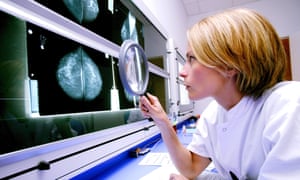GPs could use breast cancer calculator to predict risk to women
Women may be able to go to their GP to find out their risk of getting breast cancer and choose whether or not to be screened, if a new online cancer calculator devised by scientists is successful.
Cancer Research UK scientists have worked out a way to assess women’s chances of developing the disease on the basis of both genetic data and lifestyle risks. They hope to offer a reasonably good prediction by combining information on family history and genetics with other factors such as weight, age at menopause, alcohol consumption and use of hormone replacement therapy.

A radiologist examines mammograms on a lightbox with a magnifier. Photograph: REX/Shutterstock
Many lifestyle risk factors for breast cancer are known, but each one individually often does not add up to much. The cumulative effect, however, may be much more significant. The same applies to genes. Two inherited faulty genes – BRCA1 and BRCA2 – give women an increased chance of developing breast cancer. But there are many other genes that are now thought to play a small part. The researchers, for their risk assessment, have taken into account 300 different genes that could be identified.
“This is the first time that anyone has combined so many elements into one breast cancer prediction tool,” said Prof Antonis Antoniou, the lead author of the research at the University of Cambridge.
He added: “It could be a game changer for breast cancer because now we can identify large numbers of women with different levels of risk – not just women who are at high risk.
“This should help doctors to tailor the care they provide depending on their patients’ level of risk. For example, some women may need additional appointments with their doctor to discuss screening or prevention options and others may just need advice on their lifestyle and diet.
“We hope this means more people can be diagnosed early and survive their disease for longer, but more research and trials are needed before we will fully understand how this could be used.”
A large proportion of the 55,000 breast cancers diagnosed each year in the NHS have been in women at increased risk of the disease. If the calculator works well, it could lead to more of those at risk being identified early, when they could be successfully treated.
It would also mean that breast cancer screening, through mammograms, could be more accurately targeted. Not all women want to be screened, at present, because of the risk of being wrongly diagnosed with cancer. The calculator may help women decide whether they want to be screened or not.
Source: www.theguardian.com


Leave a reply
You must login or register to add a new comment .